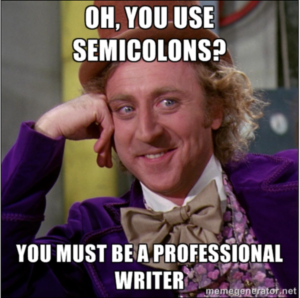LITERACY FOCUS, LENT 2: Or, How I learned to stop worrying and love the semi-colon – Mr Hodson
December 29th, 1993: an excitable 9-year-old, sitting at the family kitchen table, turns merrily to his father. ‘Dad, I’ve finished all my letters, can I play on my Gameboy now?’ The father cranes over the child ominously, his face a picture of cynicism and distrust… ‘Let me see those, boy.’
The father is my father; the missives are Christmas thank-you-letters; and the hapless child is your very own Mr Hodson. Me.
As the father reads through the son’s decidedly facile professions of gratitude, his brows furrow, his eyes narrow; his grammatical fastidiousness incensed: ‘ Aunt, in this context, does not require a capital ‘A’, and why on earth haven’t you used a single semi-colon?!’
That, for the 9-year-old Thom Hodson, was a seminal moment. Had my father been a less exacting figure it’s quite possible I’d have gone on to flunk my way through high school, becoming a notable, multi-award winning singer-songwriter, and thereby finding fame and fortune. Fate, however, had something far more important in store for me: hence, here I am, channelling my resentment at childhood humiliation into the harsh instruction of my own poor, unsuspecting charges. You. No recording contract for me, just a deep-seated respect for the semi-colon.
This term, your teachers will be emphasising the important of both the colon and the semi-colon, and an instinctive reaction for many may be: ‘I’ve got by on commas and full-stops so far, so why the big deal?’ Well…

Colons and semi-colons excite such strong passions that, in 1837, two professors at the University of Paris fought a duel – with swords – over a dispute as to whether a particular punctuation mark should be a colon or a semi-colon. The semi-colon defender suffered a slashed arm.
Since their usage became widespread and systematic in the English language – back in the 16th century – colons and semi-colon have been a means of expressing more precisely one’s meaning. Although it is possible to convey ideas using words, commas and full stops alone, the colon and semi-colon allow for a sharper degree of distinction within that expression of ideas. This may sound a bit dull, so perhaps a metaphor will assist:
If Mr Ravenhall handed you a Dulux paint-roller and asked you to paint a detailed crowd-scene, you’d think he was mad. More likely he’d provide you with a range of brush densities, thicknesses and fibres, allowing for nuanced expression of the image.
Colons and semi-colons offer a similar freedom in writing; use them!
















Post Comment
You must be logged in to post a comment.